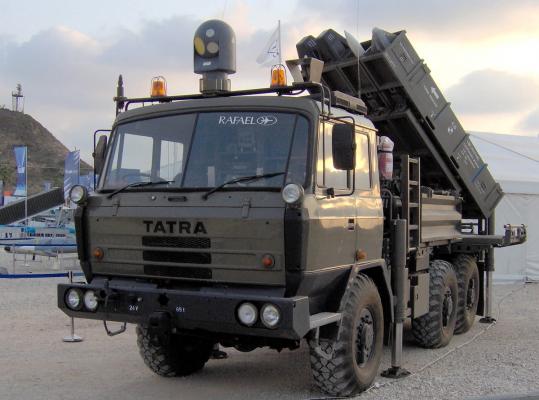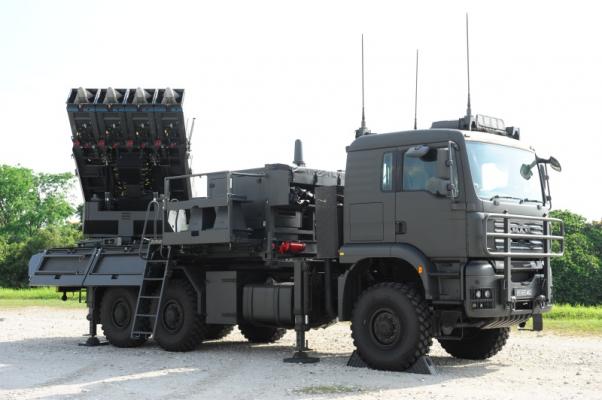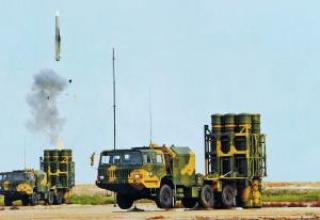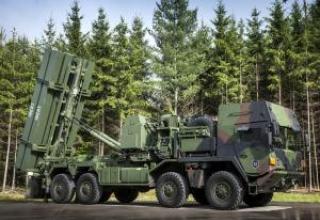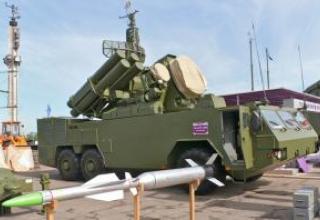Mobile anti-aircraft missile system (SAM) SPYDER (Surface-to-Air PYton and DERby) of near and medium range is designed for air defense of units of ground forces and infrastructure (command posts, communication nodes, radio equipment, bridges, airfields) from attacks by aircraft, helicopters, cruise missiles and unmanned aerial vehicles. The complex provides defeat of single and group targets at any time of day and in any climatic conditions.
SPYDER SAM system belongs to the family of anti-aircraft systems that use aircraft missiles as a means of destruction. The peculiarity of the complex is the presence of missiles with different systems of homing - guided missile Derby with an active radar head of homing (SHV) and Phyton missile with thermal SHV. This combination provides all-weather, stealth and efficiency of the combat application of the complex.
SPYDER is designed by a consortium of Israeli companies Rafael and Israel Aircraft Industries (IAI). The first version of the system, later designated SPYDER-SR (Short Range), was demonstrated at the Paris Air Show in Le Bourget in 2005. Later, Rafael and IAI announced the development of a new version of the system under the designation SPYDER-MR (Medium Range), characterized by increased combat efficiency. SPYDER-MR has maintained a high degree of continuity with the SPYDER-SR, but is equipped with a new surveillance radar and an increased stockpile of upgraded missiles with a longer range. Initially, the complex used a Phyton-4 missile, later - a more advanced Phyton-5 missile with dual-band thermal imaging GSN.
The complex is actively promoted on the international arms market, currently, the SPYDER-SR version is in service with the land forces of Georgia, Singapore and India.
The combat application of the SPYDER-SR complex took place in 2008 during the Georgian-South Ossetian conflict. On August 9, 2008 at 10:20 Georgian Air Defense Forces shot down the Russian Su-24M front bomber from the 929th State Flight Test Center (Akhtubinsk airfield) using Spyder-SR SAM system. It flew as part of a group of three bombers with the task of suppressing Georgian artillery near the village of Shindisi (between Gori and Tskhinvali). After the first landing the plane had two unsuccessful launches of Python-4 missiles, but with a third missile it was hit. The hit caused a fire and the crew ejected, but the wreckage of the plane damaged the dome of the parachute of navigator Colonel Igor Rzhavitin, as a result of which he died.
Composition:
SPIDER-SR
The SPYDER-MR mid-range complex includes a typical battery:
- the command post,
- four launchers,
- transport and charging machines.
The launcher (PU) is designed to accommodate, transport, preposition and tilt four Derby and Phyton-5 anti-aircraft missiles in various combinations (see photo1, photo2, photo3, photo4). The PU is made according to the modular principle and can be placed on different cross-country vehicles chassis. The missiles are launched directly from containers, which also serve for their transportation and storage (see photo). The launch container package is located on a swivel platform and can be hydraulically driven in both horizontal and vertical planes. In the hiking position, the rails are arranged horizontally. To increase the survivability of the missile system, the boosters can be placed at a distance from the battery command post. Information exchange can be organized via cable, fiber-optic or wireless communication lines. The TOPLITE optical detection system can be used for autonomous operation of the ESP. Calculation of the starting installation - 3 persons.
Derby and Phyton-5 SAMs as part of the SPYDER-SR complex can be used to capture the target of the missile's CNS before launch (when the missiles on the PU) and after launch. In the latter case, before target acquisition by the homing head, the missile is controlled by an inertial control system to the primary target designation data transmitted to the missile. The data transmission line is used to transmit correction commands to the missile in the middle section of the trajectory before the CNS captures the target. The firing rate is two seconds.
The command post (KP) is equipped with a three-axis Elta EL/M-2106NG ATAR 3D detection radar (see diagram). The radar allows detecting and escorting up to 60 targets at ranges of up to 35 km. The control provides the capability to conduct combat operations in a single information space of an air defence system and can receive target designation from external sources. The control cabin has two operator workplaces equipped with liquid crystal monitors (see photo).
SPIDER-MR
The SPYDER-MR mid-range complex includes a typical battery:
- the command post,
- MF-STAR detection radar,
- six launchers,
- transport and charging machines,
- the supply machine.
The SPYDER-MR launcher is placed on a cross-country vehicle chassis and has eight SSDs. Missiles are launched vertically with the subsequent inclination towards the target (for a period not exceeding 2c), which provides an opportunity to effectively organize a circular defense against various means of air attack. Derbi and Phiton-5 ASDs, which are part of Spyder-MR, are equipped with additional starting engines and provide a much longer range (up to 50 km) with the ability to maneuver at the final stage of the trajectory with an overload to 12g. The missiles are used in target acquisition mode after launch.
The new MF-STAR overview radar, developed by the Elta division of IAI, allows to detect and escort up to 60 targets at a range of up to 100 km. SPYDER-MR command post provides interaction with SPYDER-SR air defense systems or other complexes and information sources as part of a single air defense system.
Characteristics:
| SPIDER-SR | SPIDER-МR | |
| Defeat zone, km: - at a distance - in height |
1-15 0,02 - 9 |
1-50 0,02 - 16 |
| Detection range, km | 35 | 100 |
| Number of missiles on the launcher, pcs. | 4 | 8 |
Testing:
Having unique flight and tactical characteristics, MiG-25P for a long time was operated only as part of the Soviet air defense fighter aircraft. In the early 1980s, its delivery abroad began, and soon its baptism of fire took place. Even before the beginning of the large-scale Lebanese conflict, in spring 1981, the Syrians announced the destruction of the F-15.
According to the Iraqi Air Force Command, from December 1982 to October 1986, during the Iran-Iraq war, the Iraqi MiG-25 shot down an Iranian F-5E fighter, an EU-130E counter-electronic aircraft, and three Phantoms, including one in a reconnaissance version.
During Operation Desert Storm, January 17, 1991, Iraqi MiG-25 managed to shoot down an American F/A-18, and in 2002 - an unmanned reconnaissance drone Predeitor.
Sources:
- SPYDER Surface-to-Air Python 5 and Derby Air Defence Missile System, Israel
- SPYDER ADS-SR
- SPYDER ADS-MR
- Jane’s Defence Weekly, 21/VI 2006, p. 15
- http://ru.wikipedia.org/wiki/Spyder
- Сингапурский SPYDER
